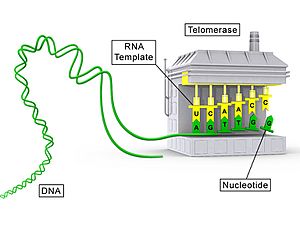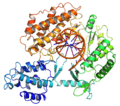Telomerase facts for kids
Telomerase is a special kind of enzyme made of RNA and protein. Think of it as a tiny builder inside your cells! Its job is to add specific DNA pieces, like "TTAGGG" in humans, to the very ends of your DNA strands. These ends are called telomeres.
Telomeres are like protective caps on your chromosomes. Chromosomes are where your DNA is stored. These caps are made of repeated DNA bits that don't carry important instructions. They act like a safety buffer.
Every time your cells divide, the chromosomes get copied. But during this copying process, a small part of the telomere cap gets lost. This is normal and doesn't harm your important DNA. However, if telomeres get too short, the cell can't divide properly anymore. That's where telomerase comes in! It helps to rebuild and keep these telomere caps at the right length.
Contents
Why Telomeres Need Telomerase
Your body is made of tiny building blocks called cells. These cells constantly divide to help you grow, heal, and replace old cells. Inside each cell, your DNA is organized into structures called chromosomes.
Protecting Your DNA Ends
Imagine your shoelaces. If the plastic tips (aglets) at the ends wear away, the laces can fray and become unusable. Telomeres are similar to these tips for your chromosomes. They protect the important DNA instructions from getting damaged or lost during cell division.
How Telomeres Shorten
Every time a cell divides, its chromosomes are copied. This copying process isn't perfect, and a small piece of the telomere at the very end of each chromosome is lost. It's like a tiny bit of the shoelace tip getting chipped off each time you tie your shoes. Without telomerase, these telomeres would get shorter and shorter with every cell division.
Telomerase: The DNA Repairer
Telomerase carries its own small piece of RNA. It uses this RNA as a guide, or "template," to add new DNA repeats to the shortened telomeres. This makes the telomeres longer again, ensuring they stay healthy and can continue protecting your chromosomes. This process is super important for cells that need to divide many times, like those involved in growth and healing.
The Discovery of Telomerase
The idea that there might be a way to fix telomere shortening was first suggested by a Soviet scientist named Alexey Olovnikov in 1973. He also thought that telomeres might be connected to how we age and even to cancer.
Nobel Prize-Winning Research
Telomerase itself was discovered in 1984. Two amazing scientists, Carol Greider and Elizabeth Blackburn, found it while studying a tiny creature called Tetrahymena, which is a type of ciliate (a single-celled organism). Their discovery was so important that they, along with Jack Szostak, were awarded the 2009 Nobel Prize in Physiology or Medicine.
Images for kids
-
Tribolium castaneum telomerase catalytic subunit, TERT, bound to putative RNA template and telomeric DNA (PDB 3KYL)
See also
 In Spanish: Telomerasa para niños
In Spanish: Telomerasa para niños




